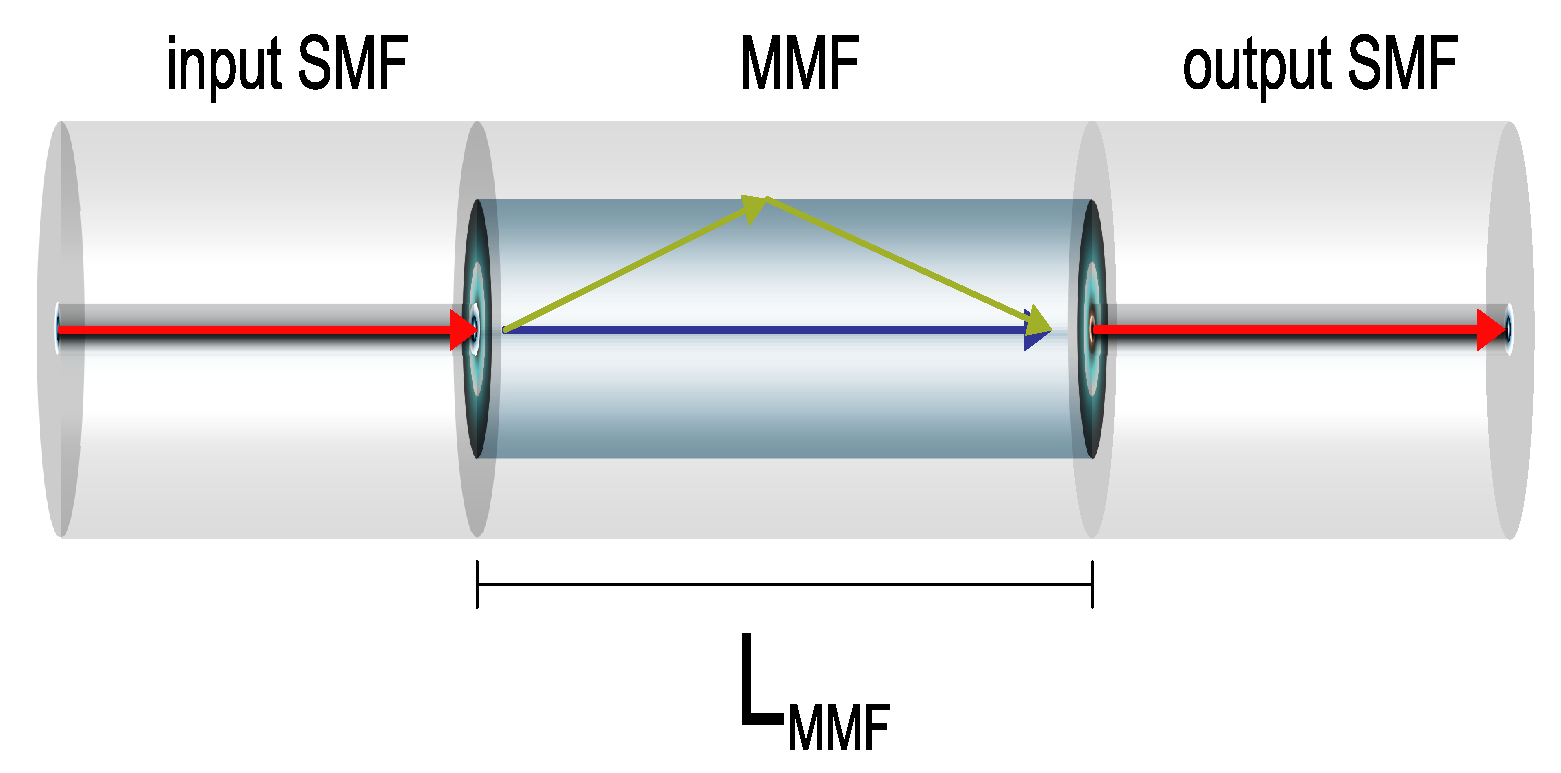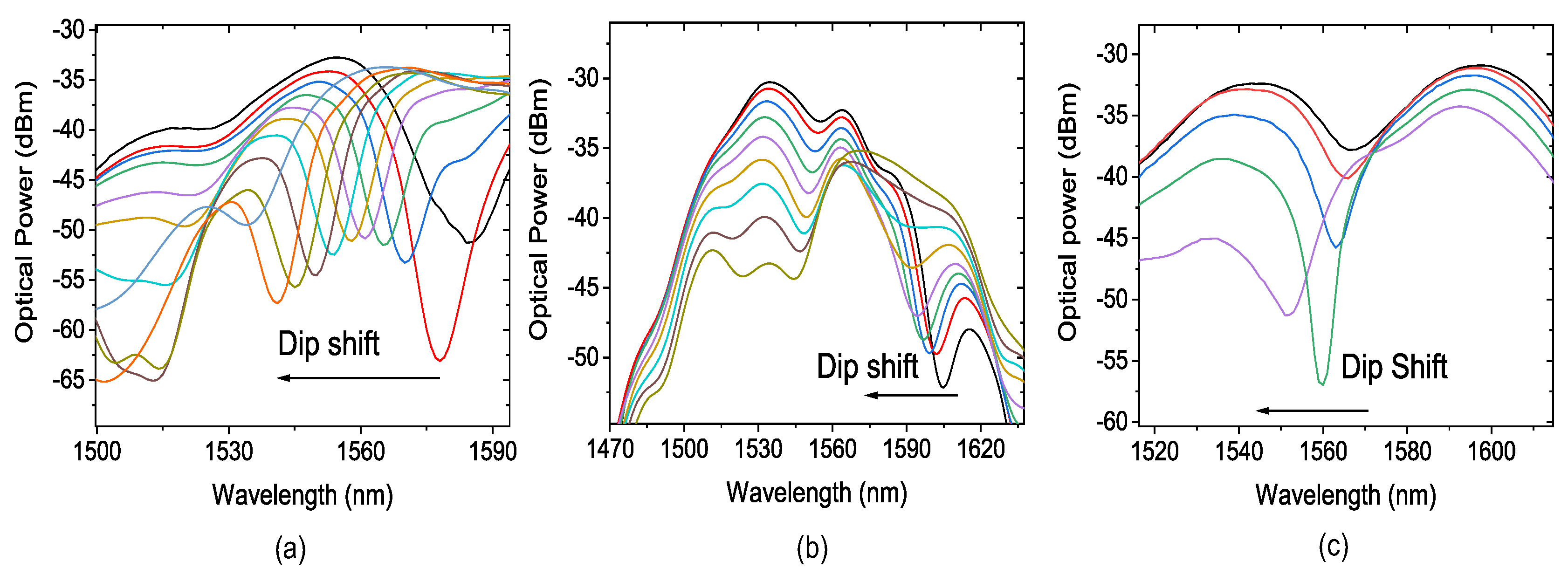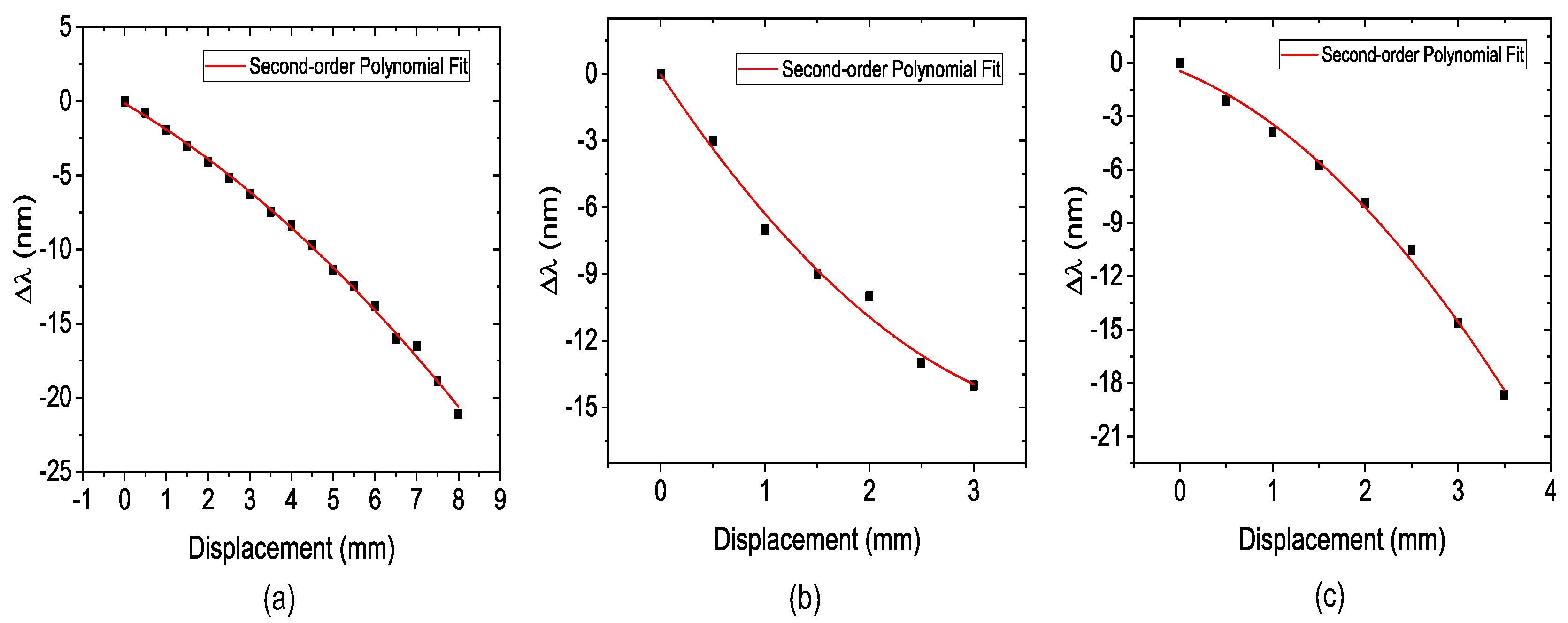MMI Sensor for Diameter Measurement †
Abstract
:1. Introduction
2. Experimental Setup
3. Results and Discussion
3.1. Structure Diameter with 80 mm
3.2. Structure Diameter with 110 mm
4. Conclusions
Supplementary Materials
Author Contributions
Institutional Review Board Statement
Informed Consent Statement
Data Availability Statement
Acknowledgments
Conflicts of Interest
References
- Amaro, R.L.; Drexler, E.S.; Slifka, A.J. Fatigue crack growth modeling of pipeline steels in high pressure gaseous hydrogen. Int. J. Fatigue 2014, 62, 249–257. [Google Scholar] [CrossRef]
- Yanga, Y.; Hongb, C.; Abrob, Z.A.; Wanga, L.; Yifan, Z. A new Fiber Bragg Grating sensor based circumferential strain sensorfabricated using 3D printing method. Sens. Actuators A Phys. 2019, 295, 663–670. [Google Scholar] [CrossRef]
- Ren, L.; Jia, Z.G.; Li, H.N.; Song, G. Design and experimental study on FBG hoop-strain sensor in pipeline monitoring. Opt. Fiber Technol. 2014, 20, 15–23. [Google Scholar] [CrossRef]
- Cohen, M.; Goldhamer, D.A.; Fereres, E.; Girona, J.; Mata, M. Assessment of peach tree responses to irrigation water ficits by continuous monitoring of trunk diameter changes. J. Hortic. Sci. Biotechnol. 2001, 76, 55–60. [Google Scholar] [CrossRef]
- Martín-Palomo, M.; Corell, M.; Girón, I.; Andreu, L.; Trigo, E.; López-Moreno, Y.; Torrecillas, A.; Centeno, A.; Pérez-López, D.; Moriana, A. Pattern of trunk diameter fluctuations of almond trees in deficit irrigation scheduling during the first seasons. Agric. Water Manag. 2019, 218, 115–123. [Google Scholar] [CrossRef] [Green Version]
- Çakir, R. Effect of water stress at different development stages on vegetative and reproductive growth of corn. Field Crops Res. 2004, 89, 1–16. [Google Scholar] [CrossRef]
- Corella, M.; Martín-Palomoa, M.; Girónb, I.; Andreua, L.; Galindoa, A.; Centenod, A.; Pérez-Lópezd, D.; Morianaa, A. Stem water potential-based regulated deficit irrigation scheduling for olive table trees. Agric. Water Manag. 2020, 242, 106418. [Google Scholar] [CrossRef]
- Goldhamer, D.A.; Fereres, E. Irrigation scheduling of almond trees with trunk diameter sensors. Irrig. Sci. 2004, 23, 11–19. [Google Scholar] [CrossRef]
- Wang, Q.; Meng, H.; Fan, X.; Zhou, M.; Liu, F.; Liu, C.; Wei, Z.; Wang, F.; Tan, C. Optical fiber temperature sensor based on a Mach-Zehnder interferometer with single-mode-thin-core-single-mode fiber structure. Rev. Sci. Instrum. 2020, 91, 015006. [Google Scholar] [CrossRef]
- Fernandes, C.S.; Rocco Giraldi, M.T.M.; de Sousa, M.J.; Costa, J.C.W.A.; Rodrigues, L.D.; da Silva, F.R.B.; Ferreira, G.F.; dos Reis, R.A.N. Strain sensing based on a core diameter mismatch structure. Microw. Opt. Technol. Lett. 2019, 61, 2013–2019. [Google Scholar] [CrossRef]
- Fernandes, C.S.; Giraldi, M.T.M.R.; de Sousa, M.J.; Costa, J.C.W.A.; Gouveia, C.; Jorge, P.; Franco, M.A.R. Curvature and Vibration Sensing Based on Core Diameter Mismatch Structures. IEEE Trans. Instrum. Meas. 2016, 65, 2120–2128. [Google Scholar] [CrossRef] [Green Version]
- Costa, J.; Franco, M.A.; Serrão, V.A.; Cordeiro, C.M.; Giraldi, M.T. Macrobending SMS fiber-optic anemometer and flow sensor. Opt. Fiber Technol. 2019, 52, 101981. [Google Scholar] [CrossRef]
- Ruan, J. Fiber curvature sensor based on concave-heterotypic cascaded fiber Sagnac interferometer. Microw. Opt. Technol. Lett. 2020, 62, 3645–3649. [Google Scholar] [CrossRef]
- Li, X.; Chen, N.; Zhou, X.; Gong, P.; Wang, S.; Zhang, Y.; Zhao, Y. A review of specialty fiber biosensors based on interferometer configuration. J. Biophotonics 2021, 14, e202100068. [Google Scholar] [CrossRef] [PubMed]
- Wu, Q.; Qu, Y.; Liu, J.; Yuan, J.; Wan, S.P.; Wu, T.; He, X.D.; Liu, B.; Liu, D.; Ma, Y.; et al. Singlemode-Multimode-Singlemode Fiber Structures for Sensing Applications—A Review. IEEE Sens. J. 2021, 21, 12734–12751. [Google Scholar] [CrossRef]
- Wang, K.; Dong, X.; Köhler, M.H.; Kienle, P.; Bian, Q.; Jakobi, M.; Koch, A.W. Advances in Optical Fiber Sensors Based on Multimode Interference (MMI): A Review. IEEE Sens. J. 2021, 21, 132–142. [Google Scholar] [CrossRef]
- Korposh, S.; James, S.W.; Lee, S.W.; Tatam, R.P. Tapered Optical Fibre Sensors: Current Trends and Future Perspectives. Sensors 2019, 19, 2294. [Google Scholar] [CrossRef] [Green Version]
- Lu, X.; Thomas, P.J.; Hellevang, J.O. A Review of Methods for Fibre-Optic Distributed Chemical Sensing. Sensors 2019, 19, 2876. [Google Scholar] [CrossRef] [PubMed] [Green Version]
- Roriz, P.; Silva, S.; Frazão, O.; Novais, S. Optical Fiber Temperature Sensors and Their Biomedical Applications. Sensors 2020, 20, 2113. [Google Scholar] [CrossRef] [Green Version]
- Wu, Q.; Semenova, Y.; Wang, P.; Farrell, G. High sensitivity SMS fiber structure based refractometer—Analysis and experiment. Opt. Express 2011, 19, 7937–7944. [Google Scholar] [CrossRef]
- Wang, Q.; Farrell, G.; Yan, W. Investigation on single-mode-multimode-single-mode fiber structure. J. Light. Technol. 2008, 26, 512–519. [Google Scholar] [CrossRef]
- Li, Y.; Liu, Z.; Jian, S. Multimode interference refractive index sensor based on coreless fiber. Photonic Sens. 2014, 4, 21–27. [Google Scholar] [CrossRef] [Green Version]
- Soldano, L.B.; Pennings, E.C.M. Optical Multi-Mode Interference Devices Based on Self-Imaging: Principles and Applications. J. Ligthwave Technol. 1995, 13, 615–627. [Google Scholar] [CrossRef] [Green Version]







Publisher’s Note: MDPI stays neutral with regard to jurisdictional claims in published maps and institutional affiliations. |
© 2021 by the authors. Licensee MDPI, Basel, Switzerland. This article is an open access article distributed under the terms and conditions of the Creative Commons Attribution (CC BY) license (https://creativecommons.org/licenses/by/4.0/).
Share and Cite
Cardoso, V.; Caldas, P.; Giraldi, M.T.; Fernandes, C.; Frazão, O.; Costa, J.; Santos, J.L. MMI Sensor for Diameter Measurement. Eng. Proc. 2021, 10, 68. https://doi.org/10.3390/ecsa-8-11324
Cardoso V, Caldas P, Giraldi MT, Fernandes C, Frazão O, Costa J, Santos JL. MMI Sensor for Diameter Measurement. Engineering Proceedings. 2021; 10(1):68. https://doi.org/10.3390/ecsa-8-11324
Chicago/Turabian StyleCardoso, Victor, Paulo Caldas, Maria Thereza Giraldi, Cindy Fernandes, Orlando Frazão, João Costa, and José Luís Santos. 2021. "MMI Sensor for Diameter Measurement" Engineering Proceedings 10, no. 1: 68. https://doi.org/10.3390/ecsa-8-11324
APA StyleCardoso, V., Caldas, P., Giraldi, M. T., Fernandes, C., Frazão, O., Costa, J., & Santos, J. L. (2021). MMI Sensor for Diameter Measurement. Engineering Proceedings, 10(1), 68. https://doi.org/10.3390/ecsa-8-11324







